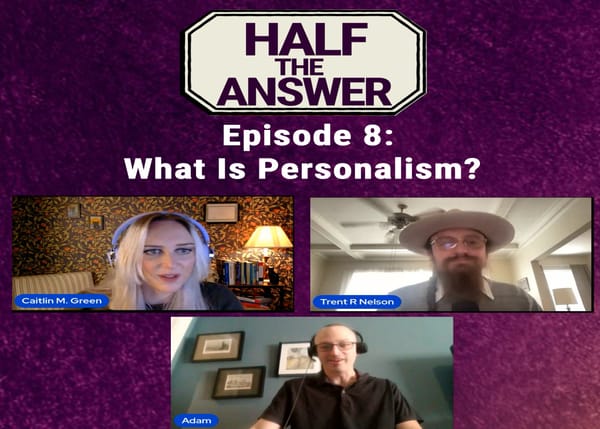The Process Is the Freak Show: On the California Gubernatorial Recall

It’s easy—far too easy—to get drawn into the candidate freak show of the current California Gubernatorial Recall Race. The candidate statements in the Official Voter Information Guide contain a treasure trove of monomaniacs and narcissists with no one in their life who loved them enough to stop them. Joel Vannresca is a “Berniecrat-Democrat” who is “Jesuit-educated” and wants you to know (since you didn’t ask) that he “Married [an] Asian American Immigrant.” Denis Lucey promises you he will uphold the Equal Protection clause guarantee to 50/50 custody for divorced parents and provides his LinkedIn URL if you want to know more. I came across far more statements from candidates regarding the divine origins of the US Constitution reading the 32 pages than I have in my entire life—and I grew up in conservative evangelical churches in Kansas.
But the real freak show is not the candidates, it’s the California recall process itself; a representative democratic process that is neither representative, nor democratic.
The process is the freak show
The California recall process requires voters to answer two questions: should the current governor be recalled? And, if recalled, who should replace him? The process was put in place under the governorship of Hirman Johnson in 1911, as part of a raft of progressive reforms to the California state constitution. His theory was that the recall process would be a “precautionary measure by which a recalcitrant official [could] be removed.” In practice, it has become the means by which the perennial losing party (in the current context of California politics, the Republicans) can relitigate a gubernatorial race it lost. The clown car of goofballs looking to replace the current governor is just a symptom of the disease that is the recall system itself.
The current recall vote is actually the result of the seventh recall attempt against Governor Gavin Newsom since he took office in 2018 with 61.9% of the vote. It’s worth going back and reviewing the justifications for prior attempts to recall Newsom as they are a check list of right wing resentments arising from opposition to undocumented immigrants, Medicare for All, tax increases, and complaints about (but no solutions for) California’s housing and homelessness crisis. In short, the people seeking a recall were conservative and didn’t like that a Democrat was elected and wanted a do over of the 2018 governor’s election.
The seventh recall effort initiated in June 2020 was more or less the same conservative grievances as prior recall attempts. This time, however, the campaign was blessed with the intervention of a global pandemic which led to social distancing, mask mandates, and a governor who seems to have felt those rules didn’t apply to him or his children.
Under California law, a recall can be initiated if a number of people equal to 12% of the participating voters in the last election sign off. The recall campaign needed 1,495,709 valid signatures to get a recall election. It obtained 1,719,900. Current polling on the recall question itself is an incredibly close margin less than 2% despite the “No” campaign massively outspending the “Yes” campaign.
A reckless gamble
The California Democratic Party has provided no guidance on who the generally liberal California voters should pick if Governor Newsom is recalled. The official position of the “Vote No” campaign is that Question 2 should be left blank. In the context of a state political environment where the best evidence indicates that conservative voters are more engaged and likely to show up, it looks reckless. The conditions are good for a majority vote for “yes” on the recall from the voters who show up, regardless of the preferences of the eligible electorate.
The first thought that occurred to me was “Why didn’t Lieutenant Governor Eleni Kounalakis run as the Question 2 choice?” The justification offered to me by people secondhand from seasoned California politicos is that the Democrats tried this exact strategy in the 2003 California recall and it just confused the voters. Some voters who wanted Lieutenant Governor Cruz Bustamante to replace the incredibly unpopular Governor Gray Davis thought they had to vote “yes” to vote Bustamante. Whereas those who voted “no” on the recall thought they could not vote for Bustamante as the replacement.
A casual glance at 2003 recall election numbers rebuts this argument. The ultimate winner, Arnold Schwartzenegger (Running Man, Total Recall), beat Bustamante by a margin of 17.1% in the 2003 recall gubernatorial replacement race. Some voters did seem to think a “no” vote meant they couldn’t vote for the replacement candidate as indicated by the difference in blank ballot responses for Question 1 (4.6%) versus Question 2 (8.0%) is 3.4%. Though it should be noted that 3.4% is much lower than 17.1%. Clearly that difference was not decisive to Schwarzeneggar’s win.
Additionally, Bustamante’s total vote of 31.7% underperformed the total “no” votes of 44.6%. Even if one discounts the 3.4% deficit for people who voted “no” on Question 1 and (we’ll assume) left Question 2 blank, that still means the “no” voters constituted 41.2% as the total voting population who cast a vote for Question 2. Again, it should be noted that 41.2% is much higher than Bustamante’s 31.7% performance. It also indicates that none, or next to none, of the “yes” votes were secret Bustamante-stans who felt they had to vote “yes” to get the Democratic governor they really wanted. Simply put, the second hand justifications I received from seasoned political class simply do not fit the actual facts of the 2003 recall election.
The only argument that remains, as near as I can tell, is one of optics. The Democratic party and the “Vote No” team want to stick by their man. (It would have been nice if their man had had a similar interest in optics surrounding compliance with COVID mandates, but I digress.) This is a weak justification for a high risk decision, especially given the likely conservative makeup of the recall voting pool mentioned above. If the recall goes forward, this pool of (likely right leaning) voters will be the group to pick among the forty-six eligible replacement candidates. If the recall moves forward the options become bleak for anyone who thinks an elected official should be representative of the people they represent.
The California Fringe Festival
The current leading replacement candidate is Larry Elder, a right wing talk show host who wants to (among other things) roll back efforts to reduce criminal sentencing, end the mask mandate regardless of the advice of medical experts, end the mandatory vaccination of state employees, and abolish the minimum wage. He currently has a commanding lead in the race for replacement governor with just under 20% of the vote. (Comparing this with Schwartzenegger’s commanding 48.6% performance in 2003 provides another reason why analogizing to the 2003 recall is not an analytically useful way to craft strategy.)
Elder’s closest opponent sits at 9.1%, a 29-year old vlogger and “real estate influencer” with an enthusiasm for blockchain and JFK named Kevin Paffrath. Paffrath takes the position that he would not impose further lock downs, but leave it to the discretion of counties and municipalities. His campaign positions on other topics range from the at-least-he-isn’t-Elder to the not-quite-sure-you-can-just-do-that. He should excite Bay Area Tech Liberaltarians and exactly no one else.
Neither of these front runners has anything approaching majority support. In a race full of fringe candidates, they have a chance because they are marginally less fringe. Neither of them could put together a winning coalition in California under normal circumstances. The only reason they have a shot is that the recall system which was designed democratic accountability can’t produce democratic representation. This is especially the case when the party that would win under normal conditions decides to put the vanity of the current governor above the practical needs of party politics and does not provide voters with a solid plan B.
These problems become further compounded in our polarized political environment where one party, the Republican Party, is actively leveraging whatever counter-majoritarian and anti-democratic features that our state and federal election systems allow. A GOP that doesn’t change it’s continued enthusiasm for Trumpist style politics is going to lose in straight California Gubernatorial races for at least a generation. But if it can generate enough resentment from a governor’s bad optics moves to get a recall, it can create circumstances where the GOP doesn’t have to get a majority to get the governor’s seat, just shy of 20% of the participating voters will do.
Better recall
Not all states conduct recalls like California. Of the 39 states with recall election procedures, California has the lowest signature threshold of any state. Most other recall states require signatures equal to at least 25% of the participating voters in the last election, if not more, in comparison with California’s minimum of 12%. A minority of states requires that the recall occur only if an elected official does something that fits within a set list of offenses. For example, Article VIII, Section 6, of the Minnesota state constitution requires a showing of “serious malfeasance or nonfeasance during the term of office in the performance of the duties of the office or conviction during the term of office of a serious crime.” Some states handle replacing a by a statutorily mandated line of succession. For example, in Virginia the Lieutenant Governor succeeds the Governor if they are removed from office. There is no reason California’s recall system has to be the unrepresentative, undemocratic, countermajoritarian mess that it is. There is polling indicating that the California electorate agrees.
Which brings us back to the freak show. The fact that California’s recall process is more insane than some of the people running in it is an accomplishment. The candidates in this race include a man whose campaign statement is “Love U”, another who describes herself as a “Billboard Queen. Icon. Experienced Politician”, and still another candidate whose candidate statement tersely instructs you to “Search Youtube” (I did, don’t waste your time). They are, undoubtedly, a freak show. But their insanity is nothing compared to a system where a governor who got over 60% of the vote in 2018 could be replaced by a candidate who could get less than 20% in 2021.




